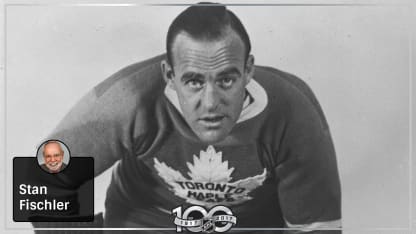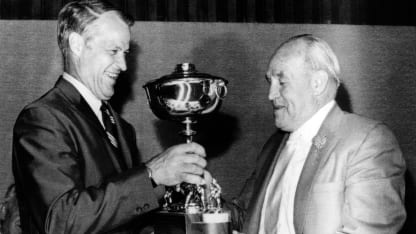As part of the NHL's Centennial Celebration, longtime hockey reporter and analyst Stan Fischler, "The Hockey Maven," will write a biweekly scrapbook for NHL.com. The scrapbook will look at some of the strange-but-true moments from the NHL's first 100 years.
How Conn Smythe's gamble paid off for Maple Leafs
Toronto owner used winnings from horse race to acquire star defenseman King Clancy

By
Stan Fischler
Special to NHL.com
While some would say this could only happen in the movies or the world of magic, the following bit of hockey legerdemain actually took place at a race track -- and, in due time, the NHL.
The implausible hockey equation went like this: Man has to build hockey team; man wants to buy superstar from rival team but has little cash; man buys horse cheap; races it as the longest of longshots (107-1); places bet on horse; horse wins race; man buys star; star helps man's team win Stanley Cup and build finest arena in Canada.
What sounds like a fairy tale actually happened in 1930. The chief protagonist was Conn Smythe, the original general manager of the New York Rangers. After Smythe signed enough first-rate players at the Rangers' first training camp in 1926, he was fired before the season started following a series of battles with Madison Square Garden president John Hammond.
Undaunted, Smythe returned to his native Toronto and, late in the Roaring '20s, bought the Toronto St. Pats, a team desperately in need of a boost, and renamed them the Maple Leafs. Coincidentally, Smythe was desperately in need of money to make the changes necessary to produce a winner.
To improve his club, Smythe decided to purchase King Clancy, arguably the best defenseman in the NHL. At the time, Clancy skated for the Ottawa Senators, a club even more desperately in need of money than Toronto. If Smythe could raise the cash, Ottawa would trade Clancy for $35,000 and a couple of players.
At first, Smythe's cockeyed plan to get Clancy seemed too bizarre for words. He would buy a cheap horse, a filly named Rare Jewel that had never won a race and looked like it would never would. Then he would enter the horse at Toronto's famed Woodbine Racetrack and hope that somehow the nag would lead the pack. Not even Robert L. Ripley, creator of the famed "Believe It Or Not" newspaper strip, would have touched this tale; let alone Rare Jewel itself.
Talk about bad: The filly cost Smythe $250 and then lost every race she entered. In her last outing before the Smythe caper, Rare Jewel looked like she was running backwards, eventually crossing the finish line in 10th place.
Undaunted, Smythe entered Rare Jewel in one of the biggest races in Canada, the Coronation Stakes for Canadian-bred 2-year-olds, on Sept. 20, 1930.
"Rare Jewel's trainer, Bill Campbell, felt it was a waste of the entry fee," wrote Anne M. Logan in her book "Rare Jewel For a King." "The jockey, Dude Foden, convinced his wife to bet on another horse, the favorite, Froth Blower."
Nonplussed by the skeptics, Smythe knew he had some things going for him. For one, he had dabbled in horses before and, for another, he was unusually lucky as a gambler. The fact that Rare Jewel was No. 7 on the card and her pole position was No. 11 couldn't hurt either.
Even more encouraging was the fact that Smythe had some friends -- others would call them suckers -- who were willing to join him and go along with what looked like a con job, putting their dough on Rare Jewel.
As it happened, with 107-1 odds, Rare Jewel would pay $214.40 on a $2 bet -- assuming, of course, she won. In addition, the payout would be $46.75 to place and $19.95 to show.
To the total astonishment of the opening day Woodbine crowd of some 15,000, Rare Jewel gave the audience a collective case of lockjaw.
The Toronto Telegram described this equine miracle of miracles in these words:
"Dude Foden, had much to do with the result. He slipped his filly in on the rail at the home turn, and before Baker, on Froth Blower, realized it, he was barging out in front with Rare Jewel a couple of lengths to the good. Froth Blower set sail after her and just failed to get up. J.P. White's Roche D' or, as great an outsider as Rare Jewel, ran third. Rare Jewel won by half-a-length over the favorite."
The victory brought Smythe $12,000; $3,750 for the winner's purse and $9,372.70 for his bet. It was the largest mutuel price paid in Canada in 1930.
When he was congratulated by P.J. Mulqueen, all Smythe could think of was: "Now we can buy Clancy. Now we are going to win the Stanley Cup."
Not so fast. Smythe seemed to have forgotten the rumor that the only team Clancy would not consider playing for was Toronto. This was all because of an on-ice feud with Maple Leafs defenseman and captain Hap Day.

© B Bennett/Getty Images
What to do? Wrote Logan: "Smythe dispatched Frank Selke to Ottawa to ask if he would ever consider playing for the Maple Leafs and King said he would 'for ten thousand dollars.'"
Still, there was uncertainty about whether Smythe's fellow directors on the Maple Leafs board could come up with the rest of the money needed for the price he'd agreed to, $35,000 cash and two players. To overcome that obstacle, Smythe pulled off a terrific public relations gambit. On Oct. 9, 1930, he placed an advertisement in the sports pages of all the Toronto newspapers:
"Fans -- The Directors of the Toronto Maple Leaf Hockey Club will make their decision on Friday regarding the purchase of Frank 'King' Clancy from the Ottawa Senators. What do you think of this deal? Write the hockey club's office, 11 King Street West. Signed C. Smythe."
The response to the ad even surprised Smythe: The Maple Leafs office was inundated with visitors, telephone calls, telegrams, and more than 2,000 letters.
"All were unanimously for buying Clancy," Logan wrote. Including the dough from Rare Jewel's miraculous win, Smythe gave the Senators the $35,000 along with forward Eric Pettinger and defenseman Art Smith (total value $15,000) for Clancy. It was the largest sum paid for a player up to that time, but it gave the Maple Leafs the cornerstone of a powerhouse.
Clancy proved to be worth every penny, and more. Canadian author Ron McAllister described him this way:
"Although he spotted almost every player who ever charged his goal at least forty to fifty pounds, Clancy's smashing, crashing, spearhead attacks, pressing up the ice with the speed of a greyhound and the drive of a bulldog, earned him a brilliant fame. His ready tongue and quick temper cost him many a trip to the penalty box, but with his temper went a determination to win that made him invaluable."
Sure enough, the Leafs went on to win the Stanley Cup in 1932. The acquisition of Clancy also enabled Smythe to round up enough money to build Maple Leaf Gardens, which would be the jewel of all NHL arenas at that time.
Reflecting on the horse that won him a superstar and a Stanley Cup, plus eventually a hockey palace, Smythe succinctly concluded, "That's what Rare Jewel did for me!"

















